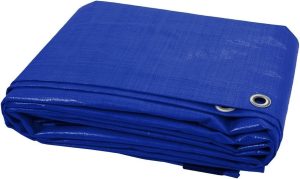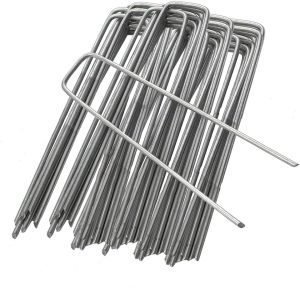Got some grass that you want to get rid of?
In this guide, we’ve explained three ways to remove your lawn. This includes digging it up, as well as some potentially easier alternatives.
Let’s get started.
How to dig up a lawn

If you have a relatively small lawn, digging it up is a good way to remove it. Although digging up a lawn is quite labour-intensive, it’s not too difficult if your lawn isn’t massive.
You will need:
- Something to cut the lawn into manageable pieces, such as a half moon lawn edger. For larger lawns, you can also buy or rent a petrol lawn edger.
- Something to lift up the lawn, such as a square shovel, or a large garden fork.
- A wheelbarrow, to remove the pieces of lawn you’ve dug up.
- A hose or sprinkler.
To dig up a lawn:
- Cut the grass as short as possible, and collect the clippings. This step is optional, but if your grass is quite long, it helps to make things a bit easier. If you don’t have a lawn mower that can collect clippings, you can leave your lawn as-is.
- Wet the lawn for 5-10 minutes, depending on how large it is, using your hose or sprinkler. Don’t completely soak it, or the sod will be very heavy when you go to lift it up. You just want to wet it enough to make the lawn easier to cut into.
- Cut the lawn into strips, about the width of your garden fork or shovel, using your lawn edger.
- Cut the lawn again, perpendicular to your previous cut, to create squares, like a chessboard. The squares should be about the size of your shovel. Alternatively, you can leave the grass in strips, and not make a second cut, but this might make things more difficult.
- Slide your shovel or garden fork under one of the pieces or strips of grass, making sure to get the lawn’s root system as much as possible, although you can cut through the roots as well.
- Lift up your piece of turf, and place it in your wheelbarrow. If you’ve cut the grass into strips instead of squares, you need to roll up each strip as you go, rather than lifting out each square individually.
At this point, you will be left with some remnants of your lawn’s roots in the ground, which will decompose within a few days.
With your old turf, you can stack it up in a pile somewhere in your garden, and wait for it to decompose. Try to pick a sunny spot, and you’ll have some nice compost to use on your garden after a few weeks.
How to remove grass by smothering it
If you have a larger lawn, or don’t want to go to the effort of digging up your grass, you can also smother it.
This process kills your grass by starving it of moisture and sunlight. It takes quite a long time, but is much less labour-intensive.
You will need:
- A large tarpaulin, or a number of small tarpaulins. You can also use an old, large carpet – or anything else that light won’t pass through.
- U-pins, or some other type of pegs.
To smother your lawn:
- Lay out the tarpaulin(s) so that it is completely covering your lawn.
- Pin down the tarpaulin at the corners, and along the edges. Consider where the water will flow if it rains. If you are concerned about run-off, you might be able to add a brick to the centre of the tarpaulin, to encourage the water to pool at the centre. You will then have to siphon off the water when you need to remove the tarpaulin, or when too much water accumulates.
- Wait about three weeks for your grass to die and compose. You may need to wait slightly longer, depending on the conditions in your garden.
When you remove the tarpaulin, you should have a completely or mostly clear area of dirt, with no grass growing. The lawn should decompose by itself over time.
How to remove grass using weed killer

In most cases, we recommend to avoid using herbicides to remove grass.
Not only can weedkillers be harmful to pets and children, but they can also affect the nutrient balance of your lawn, and have negative effects on the wider ecosystem.
It can also be difficult to apply herbicides to large lawns without specialised equipment. Plus, you will need to wait a few weeks for the lawn to fully disappear after using weed killer.
You will need:
- Weed killer, ideally one containing glyphosate. Most weed killers will also kill grass, but those containing glyphosate will be especially effective.
- A spray bottle, or a backpack compression sprayer, if you have a large lawn.
- A mask, and ideally gloves, long pants, and enclosed shoes, to prevent you from getting weed killer on your skin.
To remove a lawn using weed killer:
- Wait for the grass to dry, to avoid diluting the weed killer.
- Wait until there won’t be any rain for at least the next 6-8 hours. The last thing you want is the weedkiller being washed away from the lawn, onto other plants in your garden.
- Apply your protective equipment.
- Apply the weedkiller slowly, being methodical with the spray, as per the packet instructions. Avoid getting the herbicide anywhere other than your lawn, as much as possible. Keep the spray low to the ground to prevent the wind from taking it.
- Keep off your lawn for the next 48 hours while the weed killer is still on your lawn.
- After 1-2 weeks, inspect your lawn and see whether the grass is dying. Another application may be necessary, if your lawn was very healthy to begin with.
Conclusion
Apart from these three methods, there are other ways to remove grass from your lawn. However, most of these other techniques have their issues.
For example, you can till your lawn using a rotavator, to churn the grass into the soil, eventually killing it. However, this can lead to massive amounts of weeds growing as your grass decomposes.
These three methods are the most effective ones, in our opinion. Only the third method, using weed killer, has potential adverse effects that you need to be aware of.
Still not sure the best way to dig up and remove your lawn? Feel free to leave a comment below, and we’ll respond as soon as possible.

I’m Josh, and I’m the head writer at Lawn Care Pro.
I love everything lawns, but I’m a bit of a lawn mower nerd. I spend a lot of my free time tinkering with mowers, and planning my mowing schedule for the next few weeks.
I’m also into cars, which comes in very helpful when servicing a mower engine!







